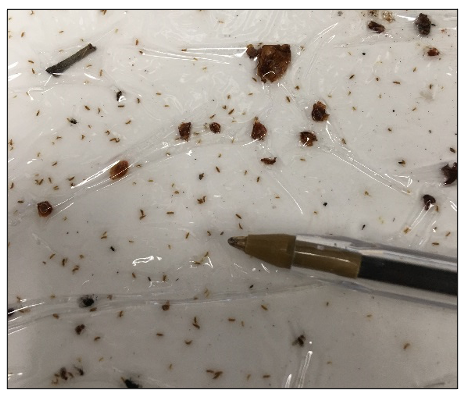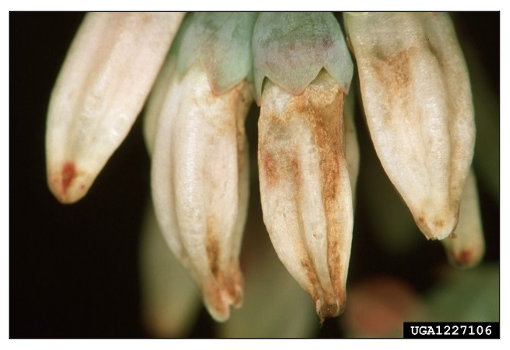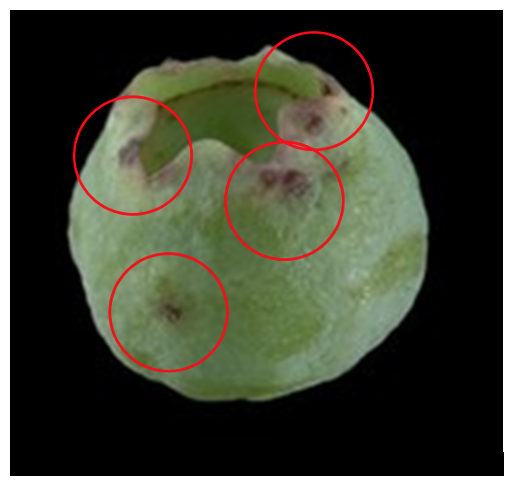Identification and Biology
Flower thrips are chronic pests of both southern highbush and rabbiteye blueberries in the southeastern United States. Flower thrips are small insects, less than 1.5 mm long (0.06 inches), with slender bodies usually yellow to orange in color. Females are typically larger than males. Adult thrips have long narrow wings fringed with fine hairs. Adults and immatures, called nymphs, have rasping-sucking mouthparts, which they use to extract sap from plant cells. Immatures look like the adults except they are smaller and have no wings.
Multiple species of flower thrips infest blueberries. These belong to the genus Frankliniella and include the Florida flower thrips (F. bispinosa), western flower thrips (F. occidentalis), and eastern flower thrips (F. tritici) (Liburd and Arevalo 2005). Examination under high magnification is needed for species identification.
Flower thrips go through multiple generations per year. They have relatively short life cycles and can complete development from egg to adult in 18-22 days under optimum conditions. Females lay their eggs within plant tissue, making them very difficult to see with the naked eye. There are four immature stages (instars) between egg and adult. The first two instars are very active while the third and fourth instars are inactive and do not feed.

Pest Status
These three species of flower thrips have a wide host range including agricultural crops, ornamentals, and some trees. Their fruit hosts include blueberries (southern highbush and rabbiteye) and strawberries. Flower thrips usually live inside the blueberry flowers. Both adults and larvae cause damage by sucking sap from flower tissues including styles, ovaries, petals and fruits, reducing the quality and quantity of fruits produced. Flower thrips may feed on pollen, which can lead to fruit abortion. These types of feeding injuries can initiate major yield losses. Additionally, females lay eggs within various flower tissues and the scars from this egg laying activity can cause mature fruit to be unmarketable. Economic damage has often been observed in early-season blueberries.


Monitoring
Monitoring is an important part of flower thrips management. Population densities of flower thrips are highly correlated with the percentage of opened flowers in a blueberry field. Flower thrips typically occur in hotspots within a field and the number of flower thrips peaks when the majority of the flowers (80-90%) are open, usually two weeks from bloom. The likelihood of flower thrips infestation in a particular field is dependent upon temperature, variety phenology and proximity to alternative host plants.
Flower thrips have an uneven distribution, occurring in hotspots across blueberry fields. Sampling should, therefore, be spread out across multiple spots within a field. Flower cluster collection can be done using re-sealable plastic bags. In this method, collect five bloom clusters from each of 5-10 randomly selected bushes from different parts of a blueberry field. Place the bloom clusters in a sealed plastic bag and place in a warm room or on a windowsill. The heat will cause the thrips to exit the blooms. If there are 2-6 thrips per bloom, the infestation is becoming problematic, and if there are more than 6 thrips per bloom, the infestation can be quite injurious, and action should be taken. Thrips numbers often increase dramatically as bloom progresses. Begin sampling bloom clusters for thrips at Stage 3. Sample two to three times a week from Stage 3 up to bloom.
Management
Pesticides are effective at controlling thrips (Liburd et al. 2017; Sial 2016). Use the action threshold of two or more thrips per individual bloom to determine when to spray. Delegate® (spinetoram), Entrust® (spinosad), and Assail® (acetamiprid) are effective against thrips. However, these insecticides are toxic to bees, which is a major concern considering the timing of thrips infestations. It is therefore extremely important to use these materials following label instructions in order to minimize unintended harmful effects to non-target organisms. Conserving natural enemies such as the predatory bug Orius insidiosus is also beneficial as these can help keep thrips populations in check. Further details are available in the Southeast Regional Blueberry Integrated Management Guide. The most recent version of the guide can be accessed at https://smallfruits.org/ipm-production-guides/.
References
Arévalo, H.A., and O.E. Liburd. 2007. Horizontal and vertical distribution of flower thrips in southern highbush and rabbiteye blueberry plantings, with notes on a new sampling method for thrips inside blueberry flowers. Journal of Economic Entomology. 100: 1622-1632.
Liburd, O.E., and H.A. Arévalo. 2005. Integrated strategies for controlling flower thrips in southern highbush blueberries. IFAS Extension IPM-140. University of Florida, Gainesville, FL.
Liburd, O.E., H.A. Arévalo, and E.M. Rhodes. 2017. Efficacy of reduced-risk insecticides to control flower thrips in early-season blueberries and their effect on Orius insidiosus, a natural enemy of flower thrips. Agricultural Sciences. 8: 356-370.
Liburd, O.E., E.M. Sarzynski, H.A. Arévalo, and K. MacKenzie. 2009. Monitoring and emergence of flower thrips species in rabbiteye and southern highbush blueberries. Acta Horticulturae. 810: 251-258.
Rhodes, E.M., O.E. Liburd, and G.K. England. 2012. Effects of southern highbush blueberry cultivar and treatment threshold on flower thrips populations. Journal of Economic Entomology. 105: 480-489.
Sial, A. 2016. Monitoring and management of thrips in blueberries. UGA Blueberry Blog. https://blog.caes.uga.edu/blueberry/2016/03/thrips/
